AckermannTh. (ed) Wind Power in Power Systems
Подождите немного. Документ загружается.


//INTEGRAS/KCG/P AGIN ATION/ WILEY /WPS /FINALS_1 4-12- 04/0470855088_ 26_CHA25 .3D – 571 – [555–586/32]
17.12.2004 10:50PM
modulation (Heier, 1998). The last condition is not fulfil led during grid faults. However,
when a fault occurs, variable-speed wind turbines are promptly disconnected to protect
the power electronic converter. Further, there are very-high-frequency phenomena when
the power elect ronic converter responds to a voltage drop. PSDSs are unsuitable for
investigating this topic. Therefore, the model incorporates a low-frequency representa-
tion of the behaviour of the converter during faults, similar to high-voltage direct-
current (HVDC) converters (SPTI, 1997).
The converters are represented as current sources, and therefore the current set
points equal the rotor currents. The current set points are derived from the set points
for active and reactive power. The active power set point is generated by the rotor
speed controller, based on the actual rotor speed value. The reactive power set point
is generated by the terminal voltage or power factor controller, based on the actual
value of the terminal voltage or the power factor. Both controllers will be discussed
below.
When the stator resistance is neglected and it is assumed that the d-axis coincides
with the maximum of the stator flux, the electrical torque is dependent on the quad-
rature component of the rotor current (Heier, 1998). If u
qr
equals u
t
, from the
assumption that the d-axis coincides with the maximum of the stator flux, then it
can be derived from Equations (25.13) and (25.16) that the following relation between
i
qr
and T
e
holds.
T
e
¼
L
m
u
t
i
qr
!
s
ðL
s
þ L
m
Þ
: ð25:18Þ
where u
t
is the terminal voltage.
The reactive power exchanged with the grid at the stator terminals is dependent on the
direct component of the rotor current. From Equations (25.16) and (25.17), neglecting
the stator resistance and assuming that the d-axis coincides with the maximum of the
stator flux, it can be shown that
Q
s
¼
L
m
u
t
i
dr
L
s
þ L
m
u
2
t
!
s
ðL
sþL
m
Þ
: ð25:19Þ
However, the total reactive power exchanged with the grid depends not only on the
control of the generator but also on the control of the grid side of the converter feeding
the rotor winding. The following equations apply to the con verter:
P
c
¼ u
dc
i
dc
þ u
qc
i
qc
;
Q
c
¼ u
qc
i
dc
u
dc
i
qc
;
)
ð25:20Þ
in which the subscript c stands for converter. In this equation, P
c
is equal to the rotor
power of the doubly fed induction generator P
r
given in Equation (25.19). P
r
may be
multiplied with the converter efficiency if the converter losses are to be included. The
reactive power exchanged with the grid equals the sum of Q
s
from Equation (25.19) and
Q
c
from Equations (25.20). Q
c
depends on the control strategy and the converter rating
but often equals zero, which means that the grid side of the converter operates at unity
power factor (see Chapter 19).
Wind Power in Power Systems 571

//INTEGRAS/KCG/P AGIN ATION/ WILEY /WPS /FINALS_1 4-12- 04/0470855088_ 26_CHA25 .3D – 572 – [555–586/32]
17.12.2004 10:50PM
25.6.5 Protection system model
The goal of the protection system is to protect the wind turbine from damage caused by
the high currents that can occur when the terminal voltage drops as a result of a short
circuit in the grid. It also has the task of preventing islanding. Islanding is a situation in
which a part of the system continues to be energised by distributed generators, such as
wind turbines, after the system is disconnected from the main system. This situation
should be prevented because it can lead to large deviations of voltage and frequency
from their nominal values, resulting in damage to grid components and loads. It can
also pose a serious threat to maintenance staff, who incorrectly assumes that the system
is de-energised after the disconnection from the transmission system.
The thermal time constants of semiconductor components are very short. Therefore,
the converter that feeds the rotor winding is easily damaged by fault currents, and
overcurrent protection is essential for the converter. The generator itself is more capable
of withstanding fault currents and is therefore less critical. The working principle of
overcurrent protection is as follows. When a voltage drop occurs, the rotor current
quickly increases. This is ‘noticed’ by the controller of the rotor side of the power
electronics converter. Then the rotor windings are shorted using a ‘crow bar’ (basically
turning the generator into a squirr el cage induction generator). A circuit braker between
the stator and the grid is operated and the wind turbine is completely disconnected. The
grid side of the converter can also ‘notice’ the volta ge drop and the corresponding
current increase, depending on the converter controls. After the voltage is restored, the
wind turbine is reconnected to the system.
The anti-islanding protection of the wind turbine acts in response to voltage and/or
frequency deviations or phase angle jumps. The grid side of the converter measures the
grid voltage with a high sampling frequency. There are criteria implemented in the
protection system for determining whether an island exists. If these criteria are met, the
wind turbine is disconnected. The criteria that are applied are a trade-off between the
risk of letting an island go undetected, on the one hand, and of incorrectly detecting an
island when there is none, leading to ‘nuisance tripping’, on the other.
The response of a doubly fed induction generator to a terminal voltage drop is a high-
frequency phenomenon. It cannot be modelled adequately with PSDS software. This
becomes clear when we look at the assumptions on which these programs are based (see
Section 25.2 and Chapter 24). Hence, if the protection system that is incorporated into a
doubly fed induction generator model is used in PSDS it will react to terminal voltage and
not to rotor current. It is thus a simplified representation of the actual protection system.
There are simulations in the literature that show the different responses of reduced-
order and complete models (Akhmatov, 2002). However, presently there are no quanti-
tative investigations that analyse the importance of the differences between the reduced-
order model and the complete mod el for the interaction with the system. The latter is,
however, the main point of interest in PSDS, so this topic requires further investigation.
Further, it must be noted that the protection system of a model of a doubly fed
induction generator that will be used in PSDSs can incorporate criteria only with respect
to the amplitude and frequency of the terminal voltage. As only the effective value of
fundamental harmonic components is studied, it will not be possible to detect phase
jumps.
572 Reduced-order Modelling of Wind Turbines

//INTEGRAS/KCG/P AGIN ATION/ WILEY /WPS /FINALS_1 4-12- 04/0470855088_ 26_CHA25 .3D – 573 – [555–586/32]
17.12.2004 10:50PM
In addition to criteria for detecting whether the wi nd turbine should be disconnected,
the protection system also includes criteria for determining whether the wind turbine
can be reconnected, as well as a reconnection stra tegy. If a protection system of a model
of a doubly fed induction generator is used in PSDS, it consists of the following
elements:
.
a set of criteria for deciding when to disconnect the wind turbine;
.
a set of criteria regarding terminal voltage and frequency for determining when to
reconnect the wind turbine;
.
a reconnection strategy (e.g. a ramp rate at which the power is restored to the value
determined by the actual wind speed).
25.6.6 Rotor speed controller model
The speed controller of a variable-speed wind turbine operates as follows:
.
The actual rotor speed is measured with a sample frequency f
ss
(Hz). The sample
frequency is in the order of 20 Hz.
.
From this value, a set point for the generated power is derived, using the characteristic
for the relationship between rotor speed and power.
.
Taking into account the actual generator speed, a torque set point is derived from the
power set point.
.
A current set point is derived from the torque set point, using Equation (25.18).
In a reduced-order model, this current set point is reached immediately as a result of the
modelling approach. In practice, the current set point will be used as input to the current
control loops and it will take a certain time to reach the desired value of the current, as
will be discussed in Chapter 26. However, the time necessary to reach the new current is
significantly below the investigated bandwidth of 10 Hz.
We will use the characteristic for the relationship between rotor speed and generator
power to arrive at a set point for generated real power. In most cases, the rotor speed is
controlled to achieve optimal energy capture, although sometimes other goals may be
pursued, pa rticularly noise minimisation. The solid line in Figure 25.8 depicts the
relation between rotor speed and power for optimal energy capture. At low wind speeds,
the rotor speed is kept at its minimum by adjusting the generator torque. At medium
wind speeds, the rotor speed varies proportionally to the wind speed in order to keep the
tip speed ratio, , at its optimum value. When the rotor speed reaches its nominal value,
the generator power is kept at its nominal value as well.
Controlling the power according to this speed – power characteristic, however, causes
some problems:
.
The desired power is not uniquely defined at nominal and minimal rotor speed.
.
If the rotor speed decreases from slightly above nominal speed to slightly below
nominal speed, or from slightly above minimal speed to slightly below minimal speed,
the change in generated power is very large.
Wind Power in Power Systems 573
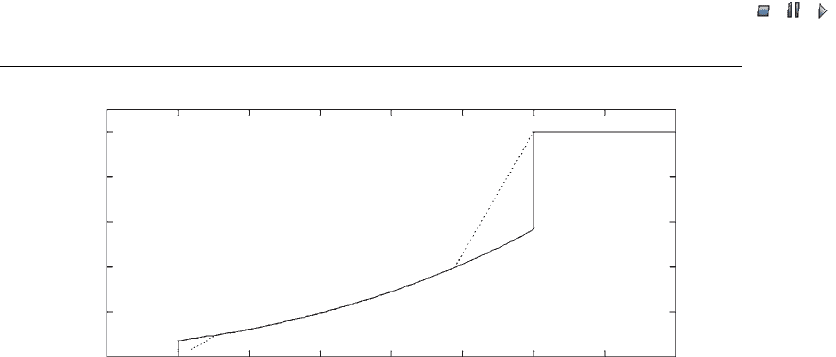
//INTEGRAS/KCG/P AGIN ATION/ WILEY /WPS /FINALS_1 4-12- 04/0470855088_ 26_CHA25 .3D – 574 – [555–586/32]
17.12.2004 10:50PM
To solve these problems, we use a control characteristic that is similar to those that lead
to optimal energy capture. The dotted line in Figure 25.8 depicts this control characteristic.
Sometimes, this problem is solved by applying more advanced con troller types, such as
integral co ntrollers or hysteresis loops (Bossanyi, 2000). The location of the points at
which the implement ed control characteristic deviates from the control characteristic
leading to optimal energy capture is a design choice. If these points lie near the minimal
and nominal rotor speed, the maximum amount of energy is extracted from the wind
over a wide range of wind speeds, but rotor speed changes near the minimum and
nominal rotor speed result in large power fluctuations. If these points lie further from
the minimal and nominal rotor speed, the wind speed range in which energy capture is
maximal is narrowed, but the power fluctuations near minimal and nominal rotor speed
are smaller.
25.6.7 Pitch angle controller model
The pitch angle controller is active only in high wind speeds. In such circumstances, the
rotor speed can no longer be controlled by increasing the generated power, as this would
lead to overloading the generator and/or the converter. Therefore the blade pitch angle
is changed in order to limit the aerodynamic efficiency of the rotor. This prevents the
rotor speed from becoming too high, which would result in mechanical damage. The
optimal pitch angle is approximately zero below the nominal wind speed. From the
nominal wind speed onwards, the optimal angle increases steadily with increasing wind
speed, as can be seen in Figure 25.7. Equations (25.6) and (25.7) are used to calculate the
impact of the pitch angle, , on the performance coefficient. The resul ting value can be
inserted in Equation (25.5) in order to calculate the mechanical power extracted from
the wind.
It should be taken into accou nt that the pitch angle cannot change immediately, but
only at a finite rate, which may be quite low because of the size of the rotor blades of
modern wind turbines. Blade drives are usually as small as possible in order to save
0.8
1.0
0.6
0.4
0.2
0
0.4 0.6 0.7 0.8 0.90.5
Power setpoint (p.u.)
1.0 1.21.1
Rotor speed (p.u.)
Figure 25.8 Optimal (solid curve) and practical (dotted curve) rotor speed-power characteristic
of a typical variable-speed wind turbine
574 Reduced-order Modelling of Wind Turbines

//INTEGRAS/KCG/P AGIN ATION/ WILEY /WPS /FINALS_1 4-12- 04/0470855088_ 26_CHA25 .3D – 575 – [555–586/32]
17.12.2004 10:50PM
money. The maximum rate of change of the pitch angle is in the order of 3–10 degrees
per second, depending on the size of the wind turbine. As the blade pitch angle can
change only slowly, the pitch angle controller works with a sample frequency f
ps
, which
is in the order of 1–3 Hz.
Figure 25.9 depicts the pitch angle controller. This controller is a proportional (P)
controller. Using this controller type implies that the rotor speed is allowed to exceed its
nominal value by an amount that depends on the value chosen for the constant K
p
.
Nevertheless, we use a proportional controller because:
.
a slight overspeeding of the rotor above its nominal value can be tolerated and does
not pose any problems to the wind turbine construction;
.
the system is never in steady state because of the varying wind speed. The advantage
of an integral controller, which can achieve zero steady state error, would therefo re be
hardly noticeable.
25.6.8 Terminal voltage controller model
A variable-speed wind turbine with a doubly fed induction generator is theoretically
able to participate in terminal voltage control, as discussed in Chapter 19. Equation
(25.19) shows that the reactive power exchanged with the grid can be controlled,
provided that the current rating of the power electronic converter is sufficiently high
to circulate reactive current, even at nominal active current.
The first term on the right-hand side of Equation (25.19) determines the net reactive
power exchange with the grid, which can be controlled by changing the direct compon-
ent of the rotor current, i
dr
. The second term represents the magnetisation of the stator.
Equation (25.19) can be rewritten in the following way
Q
s
¼
L
m
u
t
ði
dr; magn
þ i
dr; gen
Þ
L
s
þ L
m
u
2
t
!
s
ðL
s
þ L
m
Þ
; ð25:21Þ
in which i
dr
has been split in a part magnetizing the generation (i
dr
;
magn
) and a part
generating reactive power (i
dr
;
gen
).
It can be seen that i
dr, magn
, the rotor current required to magnetise the generator
itself, is given by:
Rotor
speed
(p.u.)
Maximum
rotor speed
(p.u.)
Pitch
angle
set point
(deg) (deg)
Pitch
angle
K
p
f
ps
0
Rate
limiter
(deg/s)
+
–
Figure 25.9 Pitch angle controller model. Note: K
p
is a constant; f
ps
is the sample frequency of
the pitch angle controller
Wind Power in Power Systems 575
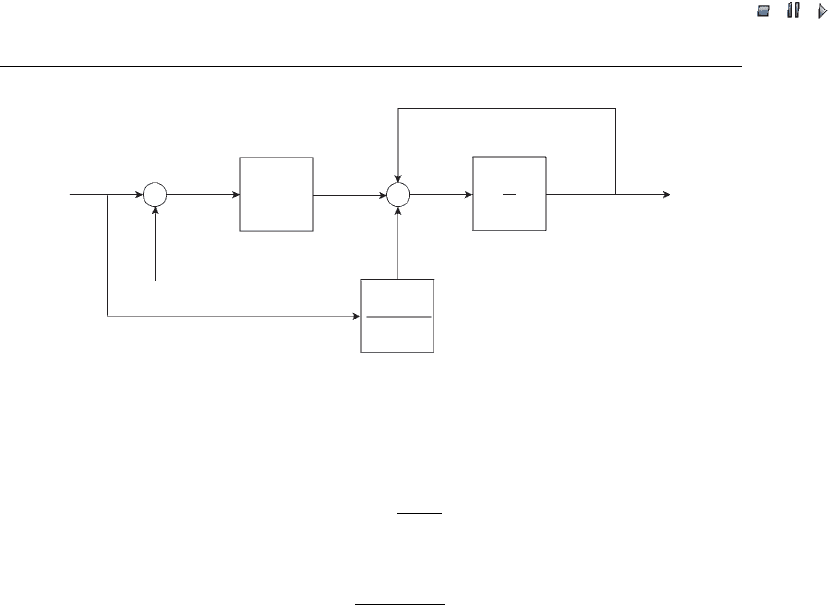
//INTEGRAS/KCG/P AGIN ATION/ WILEY /WPS /FINALS_1 4-12- 04/0470855088_ 26_CHA25 .3D – 576 – [555–586/32]
17.12.2004 10:50PM
i
dr; magn
¼
u
t
!
s
L
m
: ð25:22Þ
The net reactive power exchange between the stator and the grid is then equal to
Q
s
¼
L
m
u
t
i
dr; gen
L
s
þ L
m
: ð25:23Þ
Figure 25.10 depicts a terminal voltage controller for a doubly fed induction generator.
The value of K
v
determines the steady state error and the speed of response. This value
should not be set too high, because this leads to stability problems with the controller.
Figure 25.10 is, howeve r, only one example of a voltage controller for a wind turbine
with a doubly fed inducti on generator. There are also other possible controller topo-
logies. However, any voltage controller will correspond to the basic principle that the
terminal voltage is controlled by influencing the reactive power exchange with the grid.
If the value of K
v
is changed to zero, it results in a controller that keeps the power
factor equal to one. Currently, this is the dominant mode of operation of wind turbines
with doubly fed induction generators, because it requires only small converters and
reduces the risk of islanding. Islanding requires a balance between both active and
reactive power consumed. If the wind turbines are prevented from generating any
reactive power this situation will hardly occur.
25.7 Model of a Direct drive Wind Turbine
Figure 25.11 depicts the general structure of a model of a variable-speed wind turbine
with a direct-drive synchronous generator (Type D). Only the generator model and the
voltage controller model are discussed below. The wind speed model is identical to that
in the case of a constant-speed wind turbine model, described in Section 25.5.2. The
rotor model as well as the rotor speed and pitch angle controllers are identical to those
used in the doubly fed induction generator and were described in Sections 25.6.6 and
25.6.7, respectively. The converter and the protection system of a wind turbine with a
Terminal
voltage
(p.u.)
Voltage
reference
(p.u.)
Set point
for i
dr,gen
Set point
for i
dr,magn
(p.u.)
(p.u.)
(p.u.)
i
dr
K v
1
–u t
ω
s
L
m
+
+
+
–
–
s
Figure 25.10 Voltage controller model for a wind turbine with a doubly fed induction generator
(Type C). Note: K
v
is the voltage controller constant; u
t
is the terminal voltage; !
s
is the angular
frequency of the stator; L
m
is the mutual inductance; i
dr
is the direct component of the rotor current;
i
dr,magn
and i
dr,gen
are the currents to magnetise the generator and in the generator respectively
576 Reduced-order Modelling of Wind Turbines
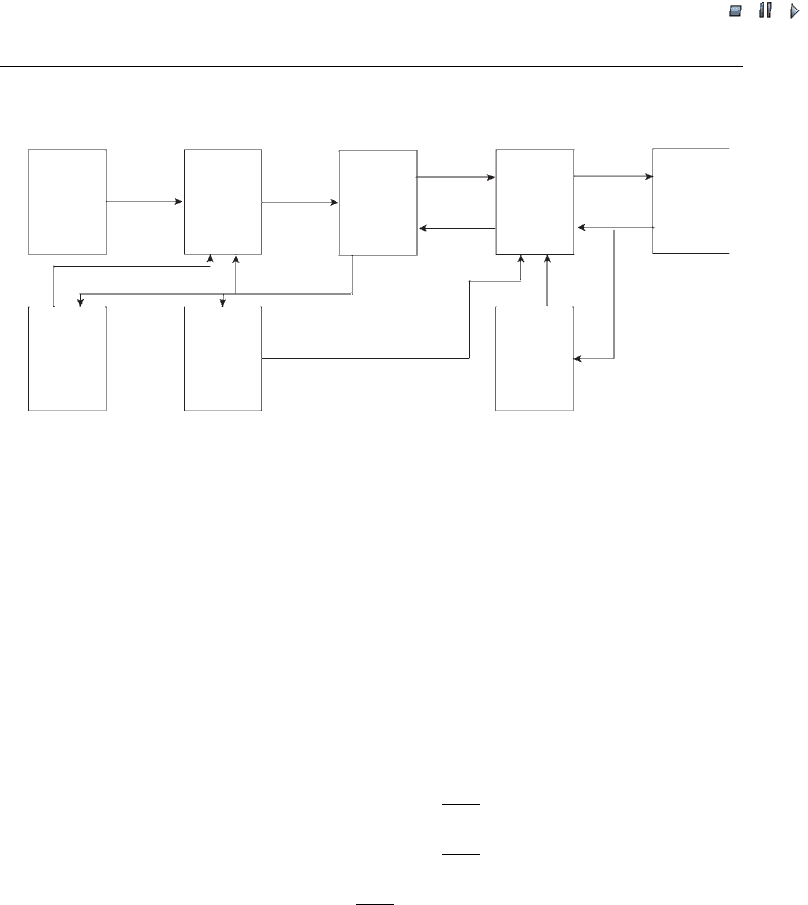
//INTEGRAS/KCG/P AGIN ATION/ WILEY /WPS /FINALS_1 4-12- 04/0470855088_ 26_CHA25 .3D – 577 – [555–586/32]
17.12.2004 10:50PM
doubly fed induction generator are different from that of a direct-driv e synchronous
generator. However, because of the simplifying assumptions used in models for dynamic
simulations, the analyses in Sections 25.6.4 and 25.6.5 also hold for the model of the
converter and the protection system of a direct-drive wind turbine. For the reasons
mentioned in Section 25.5.1, we will not discuss the grid model.
25.7.1 Generator model
According to Kundur (1994), the voltage equations of a wound rotor synchron ous
generator in the dq reference frame, taking into account the assumptions in Section
25.4, are:
u
ds
¼R
s
i
ds
!
m
qs
þ
d
ds
dt
;
u
qs
¼R
s
i
qs
þ !
m
ds
þ
d
qs
dt
;
u
fd
¼ R
fd
i
fd
þ
d
fd
dt
:
9
>
>
>
>
>
>
=
>
>
>
>
>
>
;
ð25:24Þ
The subscript fd indicates field quantities. Note that for the stator equations the
generator convention is used (i.e. positive currents are outputs). The flux equations are:
ds
¼ðL
dm
þ L
s
Þi
ds
þ L
dm
i
fd
;
qs
¼ðL
qm
þ L
s
Þi
qs
;
fd
¼ L
fd
i
fd
:
9
>
=
>
;
ð25:25Þ
All quantities in Equations (25.24) and (25.25) are in per unit values.
In the case of a permanent magnet rotor, the expressions for u
fd
and
fd
in
Equations (25.24) and (25.25) disappear because they refer to field quantities, and
expression for
ds
in Equations (25.25) becomes
Wind
speed
model or
measured
sequence
Wind
speed
Mechanical
power
Rotor
model
Model of
direct
drive
snchro-
nous
generator
Active
and
reactive
power
Stator
currents
Active
power
set point
Reactive
power
set point
Active
and
reactive
power
Voltage
and
frequency
Rotor
speed
Pitch
angle
Pitch
angle
controller
Rotor
speed
controller
Terminal
voltage
controller
Funda-
mental
frequency
grid
model
Converter
and
protection
system
Figure 25.11 General structure of a model of a variable-speed wind turbine with a direct-drive
synchronous generator (Type D)
Wind Power in Power Systems 577

//INTEGRAS/KCG/P AGIN ATION/ WILEY /WPS /FINALS_1 4-12- 04/0470855088_ 26_CHA25 .3D – 578 – [555–586/32]
17.12.2004 10:50PM
ds
¼ðL
ds
þ L
s
Þi
ds
þ
pm
; ð25:26Þ
in which
pm
is the amount of flux of the permanent magnets mounted on the rotor that
is coupled to the stator winding. When neglecting the d /dt terms in the stator voltage
equations, the voltage flux relationships become:
u
ds
¼R
s
i
ds
þ !
m
ðL
s
þ L
qm
Þi
qs
;
u
qs
¼R
s
i
qs
!
m
ðL
s
þ L
dm
Þi
ds
;
u
fd
¼ R
fd
i
fd
þ
d
fd
dt
:
9
>
>
>
=
>
>
>
;
ð25:27Þ
The d /dt terms in the expressions for u
ds
and u
qs
are neglected because the associated
time constants are small, and taking them into account would result in the need to
develop a detailed representation of the power electronic converter. That would include
phenomena that we are not interested in at this point. For a complete model of this wind
turbine type, including the d /dt terms in the stator equations and a full converter
model, see for instance, Chen and Spooner (2001).
The following equation gives the electromechanical torque:
T
e
¼
ds
i
qs
qs
i
ds
: ð25:28Þ
Based on this equation, the set point for the stator currents can be calculated from a
torque set point generated by the rotor speed controller. The equation of motion is given
by Equation (24.14) (page 545). The active and reactive power of a synchronous
generator are given by:
P
s
¼ u
ds
i
ds
þ u
qs
i
qs
;
Q
s
¼ u
qs
i
ds
u
ds
i
qs
:
)
ð25:29Þ
It has to be emphasised that the generator is fully decoupled from the grid by the power
electronic converter. Therefore, the power factor of the generator does not affect the
reactive power factor at the grid connection. The latter is determined by the grid side of
the converter and not by the operating point of the generator. The expression for Q
s
in
Equations (25.29) is therefore of limited interest when studying the grid interaction but
is important when dimensioning the converter. The generator parameters are given in
Table 25.4.
25.7.2 Voltage controller model
The voltage controller applied in a direct-drive wind turbine is different from that in a
wind turbine with a doubly fed induction generator because the generator is fully
decoupled from the grid. It is therefore not the generator that generates active power
and controls the terminal voltage but the power electronic converter. The generated
reactive power is given by the expression for Q
c
in Equations (25.20). The model of the
voltage controller is depicted in Figure 25.12. It assumes that the term inal voltage u
t
is
equal to u
qc
in Equations (25.20). Similar to the terminal voltage controller of a doubly
578 Reduced-order Modelling of Wind Turbines
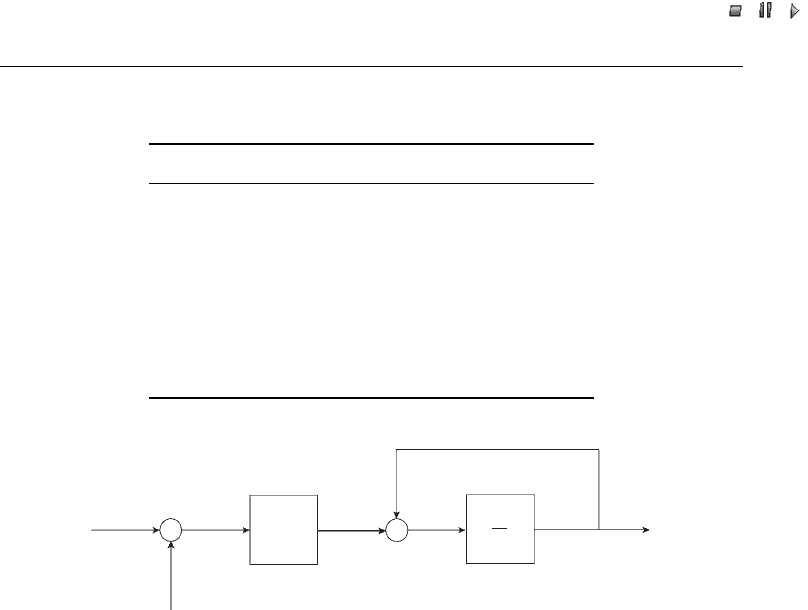
//INTEGRAS/KCG/P AGIN ATION/ WILEY /WPS /FINALS_1 4-12- 04/0470855088_ 26_CHA25 .3D – 579 – [555–586/32]
17.12.2004 10:50PM
fed induction generator, there may be alternative controller topologies here, too. How-
ever, they are all based on the principle that the reactive power exchange with the grid
has to be controlled in order to influence the terminal voltage. To simulate wind
turbines operating at unity power factor, i
dc
must be kept at zero, and the voltage
controller can be removed.
25.8 Model Validation
25.8.1 Measured and simulated model response
In this section, the model’s responses to a measured wind speed sequence will be
analysed and then compared with measurements. The measurements were obtained
from wind turbine manufacturers under a confidentiality agreement. Therefore, all
values except wind speed and pitch angle are in per unit and their base values are not
given. We used Matlab
TM
to obtain the simulation results.
Figure 25.13(a) depicts a measured wind speed sequence. In Figures 25.13(b)–
25.13(d), respectively, the simulated rotor speed, pitch angle if applicable and output
power are depicted for each of the wind turbine types. Figure 25.14(a) shows three
measured wind speed sequences. In Figures 25.14(b) and 25.14(c), respectively, the
measured rotor speed and pitch angle of a variable-speed wind turbine with a doubly
Table 25.4 Simulated synchronous generator parameters
Generator characteristic Value
Number of poles, p 80
Generator speed (rpm) 9–19
Mutual inductance in d-axis, L
dm
(p.u.) 1.21
Mutual inductance in q-axis, L
qm
(p.u.) 0.606
Stator leakage inductance, L
s
(p.u.) 0.121
Stator resistance, R
s
(p.u.) 0.06
Field inductance, L
fd
(p.u.) 1.33
Field resistance, R
fd
(p.u.) 0.0086
Inertia constant, H
m
(s) 1.0
Terminal
voltage
(p.u.)
Voltage
reference
(p.u.)
Set point
for i
dc
(p.u.)
(p.u.)
i
dc
K
v
–
+
+
–
s
1
Figure 25.12 Voltage controller model for wind turbine with direct drive synchronous generator.
Note: K
v
is the voltage controller constant; i
dc
is the direct component of the converter current;.
Wind Power in Power Systems 579
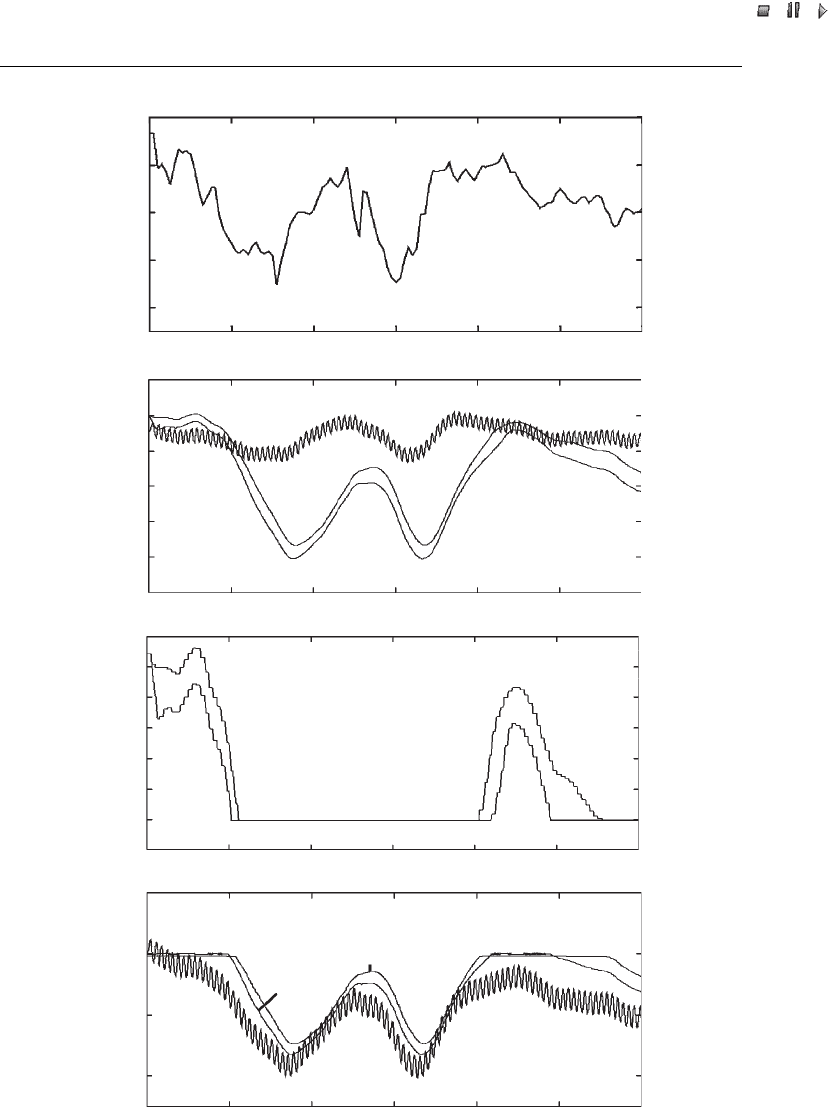
//INTEGRAS/KCG/P AGIN ATION/ WILEY /WPS /FINALS_1 4-12- 04/0470855088_ 26_CHA25 .3D – 580 – [555–586/32]
17.12.2004 10:50PM
10
0102030405060
02030405060
0102030405060
0102030405060
Time (s)
Time (s)
Time (s)
Time
(
s
)
Wind speed (m/s)Rotor speed (p.u)Pitch angle (deg)Output power (p.u.)
0.6
0.8
1.0
1.2
–1
0
1
2
3
4
5
6
0.92
0.94
0.96
0.98
1.00
1.02
1.04
8
10
12
14
16
Constant speed
Direct drive
Doubly fed
Doubly
fed
Doubly fed
Doubly fed
Direct
drive
Direct
drive
Direct
drive
Constant speed
(a)
(b)
(c)
(d)
Figure 25.13 Simulation results: (a) measured wind speed sequence; (b) simulated rotor speed;
(c) simulated pitch angle; and (d) simulated output power, by wind turbine type. Note:Constant
speed ¼constant-speed wind turbine; Direct drive ¼variable-speed wind turbine with a direct-drive
synchronous generator; Doubly fed ¼variable-speed wind turbine with a doubly fed induction generator
580 Reduced-order Modelling of Wind Turbines
